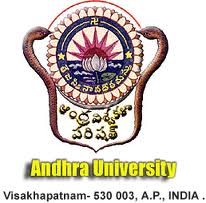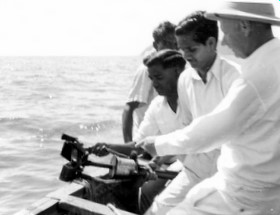History
Established in 1926, the Andhra University, located in Visakhapatnam (Waltair) on the north east coastal Andhra Pradesh, is one of the premier universities in India. The University logo - the rising sun with its rays of light- explains its mission “Thejasvi na vadhitamasthu” (May the Divine Light illuminate our studies). Its foundation Vice-Chancellor Dr. Cuttamanchi Ramalinga Reddi (1926-1930; 1936-1949) used to remark, “It is my ambition to be the Voltaire of this country. I shall, of course, fail but it is worth the trial’. A Cambridge educated intellectual, Dr. Reddy had set the seal and fought for a teaching residential university and emphasized that students should be more guided than taught. Following Dr. Reddy’s resignation in protest of the repression of Salt Satyagraha movement (India’s independence struggle), another intellectual and visionary Professor Sarvepalli Radha Krishnan (1931-1936) succeeded him as the Vice-chancellor. Dr. Radhakrishnan was a philosopher-king, an educationalist who had already served as a Pro-Chancellor of Mysore University, started several honours courses in arts and sciences and expanded the physical facilities of the university. During his term, the philanthropist scholar Maha Raja Vikrama Deo Varma of Jeypore, acclaimed as Indian Carnegie, contributed generously to make this university a reality.


These intellectual giants, Dr. Reddy and Dr. Radha Krishnan, actively shaped the university on Cambridge style. They took the initiative to attract a host of distinguished people in the country to take up professorships at the nascent university. A partial list includes Nobel Laureate Sir C.V. Raman (Honorary Professor in Physics), eminent physicist Prof. S. Bhagavantham, and educationalist Dr. J.C. Coyjee (Economics), Dr. Ludwig Wolfe (Chemistry), Dr. Humayun Kabir (Philosophy), Dr. Hiren Mukherjee (History), Dr. Lanka Sundaram (Politics) and Dr. V.K.R.V. Rao (Economics).The’Father of Indian Phycology’ or ‘Father of Indian Algology’ Dr. M.O.P. Iyengar (Ph.D. London) , The doyen of Indian Geologists Professor C. Mahadevan and the illustrious marine biologist Prof. R. Gopala Aiyar were recruited to head the Botany, Geology and Zoology departments respectively. It is to be noted that most of these professors were trained either at Oxford or Cambridge. Dr.Sarvepalli Gopal from the autobiography of his father (Dr. Radha Krishnan) quoted: “The list of recruits to the faculty of the Andhra University in the thirties is a roll-call of distinguished Indians in the sixties and seventies.” Later on Dr. Radha Krishnan served as Spalding professor of Eastern Religions at Oxford, Vice-Chancellor of Benaras Hindu University, Ambassador to the Soviet Union, Vice-President of India and President of India. Dr. C.R. Reddy returned to the university as its Vice-Chancellor for 13 years till 1949. Dr. V.S. Krishna (an Oxford graduate in Economics and a Ph.D from Vienna) was chosen as the Vice -Chancellor and served the university for the next 12 years till he became the Chairman of the University Grants Commission. During his time also the drive continued to recruit outstanding scientists and teachers trained at Cambridge, Oxford, University of London, Imperial College London, Princeton University, Harvard and Yale. Thus the university with its galaxy of dedicated professors carved an excellent name. Successive Vice-chancellors of the University initiated new courses to provide trained manpower to cater to the needs of the Nation.
The first Education commission of 1948-49 with Prof. S.Radhakrishna as Chairman, in its report recommended that the Andhra University with its unique location close to the coast should be developed as one of the centres of teaching and research in Marine Sciences. The history of teaching and research in different branches of Marine Sciences in the Andhra University can be traced back to the late Prof. R.Gopala Aiyar organized in 1947 the B.Sc. honors course in Zoology with Marine Biology as a special subject. He also initiated and directed research in various aspects of marine biology coupled with hydrography. About the same time Prof. C. Mahadevan, the then Head of the Department of Geology initiated investigations in Marine Geology.
Consistent with the healthy practices that the University had followed, the Department was initially headed, in succession, for proper orientation and direction by retired Directors of Indian Meteorological Department Dr. N.K.Sur and Dr. S.R.Savur, and later by Prof. M.S.Krishan, the renowned geologist and retired Director of Geological Survey of India.
The Department of Meteorology & Oceanography, Andhra University has been the first and foremost in India to offer post graduate teaching and research programs in Oceanic and Atmospheric sciences. The Department was started in 1948 and over the years it contributed immensely for the development of newly emerging branches of science under the stewardship of Prof. R. Ramanadham (Imperial College, London).
Marine studies in the Andhra University gained momentum and a sense of direction when Prof. E.C.La Fond, Head U.S. Navy Electronics Laboratory came to Andhra University as a US Fulbright Visiting Professor during 1952-53. Prof. La Fond, a pioneer in physical oceanography, published extensively with Drs. Sheppard, Emery, Dietz, Knauss and Tully of the Scripps Institution of Oceanography. Dr. La Fond made significant contributions on sea level, thermal structure of the oceans, transmission of sound velocities, slicks, internal waves, and sub-marine geology. He borrowed some equipment and with his wife Mrs. Katherine La Fond and two sons Bill (11) and Bob (8) arrived at Andhra University, Waltair on 27 September 1952. During his first visit, he had brought together Prof. S.R.Savur (Meteorology and Oceanography), Prof. C. Mahadevan (Geology) and Prof. P.N. Ganapati ( Zoology) to investigate the Bay of Bengal. Unmindful of the of the rigours and inconveniences of life in the Indian naval minesweepers he launched a shipboard training program for a band of young researchers. Again at the request of the Andhra University in 1954 to the Fulbright Foundation, Prof. La Fond and Mrs. Katherine La Fond returned to the Andhra University in 1955-56. Under Prof. La Fond’s leadership a total of 47 research cruises were conducted into the Bay of Bengal to unravel the impact of reversing monsoons and upwelling of subsurface waters unique to the Bay of Bengal on the physical, chemical and biological features. An excellent band of young researchers were trained, several received doctorate degrees in physical, geological and biological oceanography. These researchers constituted the much needed oceanographic manpower at the various marine science institutes in India during sixties and seventies. Their commitment to the Indian Seas made Dr. La Fond and Mrs.Katherine La Fond to take up employment with Woods Hole Oceanographic Institution. Dr. La Fond was the chief scientist on board R/V Anton Brunn and conducted U.S. Program in Biology in the Arabian Sea and the Bay of Bengal in 1963 as a part of the International Indian Ocean Expedition. Dr. La Fond Invited six Indian scientists to participate in this expedition. Professor La Fond had placed Andhra University on the oceanographic map of the world that deservedly earned him the name “Father of Modern Oceanography in India”.
